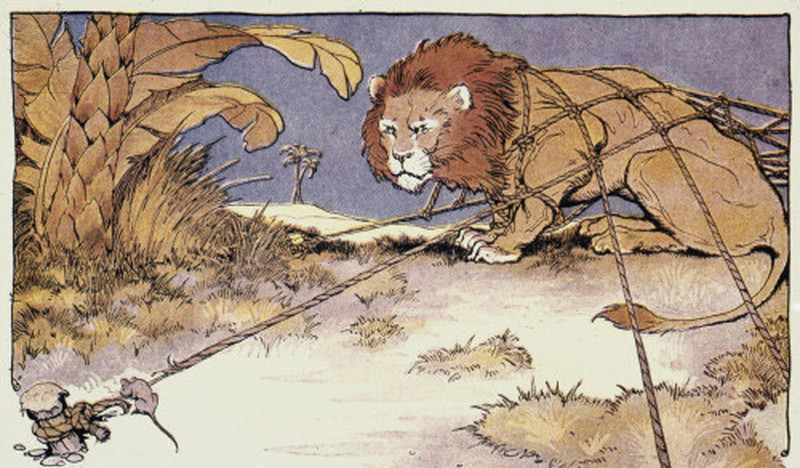
The word “fable” comes from the Latin word “fabula” and means “stories.” Hundreds of fables are credited to Aesop who was believed to have lived in the kingdom of Thrace in the 500 BCE. The fables were passed on through oral history, which means they were told aloud from person to person. Most of Aesop’s fables deal with animals as the main character who take on human characteristics. Most end with a moral or statement, which is a lesson that the fable teaches.
Some of the most famous fables include:
The Fox and the grapes: A hungry fox wants some juicy grapes. But they hang high up on a vine. He tries to get them but to no avail. Finally, he gives up and walks away scornfully. “What a fool I am,” he says. “Here I am wearing myself out to get a bunch of sour grapes that are not worth gaping for.” The moral of the tale is that you often hate what you cannot have.
The lion and the mouse: A mouse begs a lion for mercy and, after he is set free, promises that he will help the lion some day in return. A few days later the lion roams through the jungle and gets caught in a trap set up by hunters. The mouse sees the lion trapped and remembers to help him. He gnaws through the trap and frees the lion. The moral of the story is that no matter who you are or what size you are you can always help someone. Being helpful to others is the most significant virtue, and everyone has a unique way of helping.
The tortoise and the hare: The story is about a race between the persevering tortoise and the boastful hare. The hare ran very fast. But the tortoise walked very slowly. The proud hare rested under a tree and soon fell fast asleep. The tortoise eventually caught up and walked past the tree and steadily reached the goal. At last, the tortoise won the race. The moral of the story is that slow and steady wins the race.
The fox and the crow: A hungry fox comes upon a crow up in a tree with a bit of cheese in its mouth. The fox begins to talk to the crow, telling her how beautiful she is and how she must have a beautiful voice to match. At first, the crow stays silent, holding on to her cheese. But at last, after much flattery, she opens her beak wide and down falls the cheese into the fox’s mouth. The moral of the story is: Don’t believe everything you hear; not everyone has your best interests at heart.
To read the complete tales, check out Aesop’s Fables from OverDrive. To learn more about Aesop and his fables, check out Britannica School Edition and Explora for Elementary School. You’ll find full-text articles available from encyclopedias, magazines, and eBooks. Explora will also provide you with the full-text of Aesop’s Fables. Simply type in the keyword “Aesop’s Fables.”
OverDrive: About Privacy & Terms, Privacy Policy, and Terms & Conditions.
Britannica School Edition: About Privacy & Terms, Privacy Policy, and Terms & Conditions.
Explora for Elementary School: About Privacy & Terms, Privacy Policy, and Terms & Conditions.